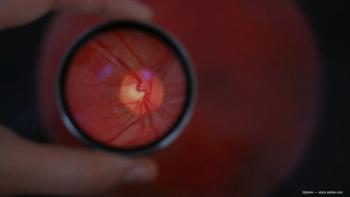
Poor oral health may be associated with POAG
Recent tooth loss and periodontal disease have been linked to primary open-angle glaucoma in a large prospective study of male health professionals.
Take-home message: Recent tooth loss and periodontal disease have been linked to primary open-angle glaucoma in a large prospective study of male health professionals.
Reviewed by Jae Hee Kang, ScD
Recent tooth loss-with or without periodontal disease-was associated with a significantly increased risk of primary open-angle glaucoma (POAG), according to findings from a long-term prospective study of oral health in male health professionals.
Recent:
“We observed that men who differed in number of natural teeth, in whether they had any periodontal disease, or in whether they had ever received root canal treatment, did not show differences in the risk of developing POAG,” said Jae Hee Kang, ScD, co-author of the study recently published in Ophthalmology.1 “However, compared to men who reported no tooth loss, men who reported losing one or more teeth recently (in the past 2 years) had a 45% increased risk of POAG (95% CI, 1.06-1.97) and men who reported having both periodontal disease and had lost one or more teeth in the past 2 years had an 85% increased risk of POAG (95% CI, 1.07-3.18).”
Related:
This association did not differ by IOP at diagnosis, but other possible associations were identified, said Dr. Kang, assistant professor of medicine, Channing Division of Network Medicine, Department of Medicine, Brigham and Women's Hospital and Harvard Medical School, Boston.
“We observed some suggestion that these relations were strongest in those whose paracentral vision was primarily affected versus those whose peripheral vision was primarily affected,” said Dr. Kang, adding that paracentral vision loss in POAG has previously been shown to be related to impaired blood flow.
Testing the hypothesis
To investigate the hypothesis that poor oral health may have systemic effects that may also adversely affect the eye, the researchers analyzed 26 years of data from the Health Professionals Follow-up Study (HPFS), which was designed to determine what factors contribute to long-term health in men. They reviewed data of 40,536 participants who were followed biennially from 1986 to 2012.
Using information from the 2-year updates, such as reports of periodontal disease, the participants could be categorized as having good oral health versus poor oral health. Researchers could then compare the rates of development of POAG in the two groups over time.
Related:
“We also had a wealth of information on additional health variables, such as body mass index, smoking, and diabetes so that we could account for these factors in our analyses,” Dr. Kang said.
The 485 cases of POAG that were confirmed with medical records were classified into subtypes defined by IOP ≥ or < 22 mm Hg and visual field loss pattern at diagnosis (peripheral loss only or early paracentral loss). Multivariate rate ratios adjusted for key covariates with 95% confidence intervals were estimated.
More:
Although a modest increased risk of POAG was observed in this study, observational epidemiologic studies alone cannot establish causal relations, and any clinical recommendations are inappropriate at this time, Dr. Kang said.
“Nevertheless, the findings of the study raise the possibility that systemic adverse effects of poor oral health may also impact eye health, and more confirmatory studies are warranted,” she said.
Recent:
This study follows earlier published studies by several of the co-authors of this paper (Leslie Hyman, PhD, and John Danias, MD, PhD), which found that individuals with glaucoma had higher bacterial loads and fewer teeth than those without glaucoma. Because the earlier work had a small sample size and was conducted in a clinic-based rather than a population-based study sample, the authors were interested in collaborating on a larger study using the HPFS data.
The proposed association between poor oral health and POAG derives from the shared factors of impaired blood flow and endothelial dysfunction, as well as the observation that treatment of periodontal disease has been shown to improve systemic blood flow and endothelial function, Dr. Kang said.
More glaucoma:
“Therefore, we hypothesized that poor oral health, manifesting as periodontal disease and tooth loss, may be associated with POAG,” she said.
Although studies often evaluate both women and men, the investigators decided to use data from the male-only HPFS since oral health questions were asked much less frequently in a similar study in women (the Nurse’s Health Study).
Related:
“We speculate that there may not be large differences by gender, as periodontal disease has been associated with various systemic diseases, such as diabetes, cardiovascular disease, rheumatoid arthritis, certain cancers, and neurodegenerative diseases in a similar manner for men and women,” Dr. Kang said.
She added that some prior small studies have not observed any differences by gender.
More:
Reference
1. Ophthalmology. 2016;123:2318-2327. doi: 10.1016/j.ophtha.2016.07.014. Epub 2016 Aug 20.
Jae Hee Kang, ScD
This article was adapted from a study published in Ophthalmology as well as a presentation by principal investigator Louis Pasquale, MD, at the 2016 meeting of the American Glaucoma Society. Dr. Kang did not report any relevant disclosures.
Newsletter
Don’t miss out—get Ophthalmology Times updates on the latest clinical advancements and expert interviews, straight to your inbox.









































